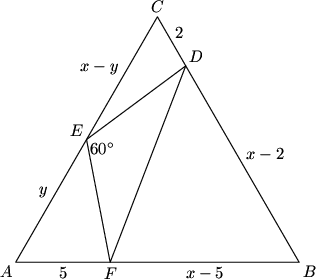Difference between revisions of "2007 AIME I Problems/Problem 15"
(+ solution) |
|||
| Line 7: | Line 7: | ||
Denote the length of a side of the triangle <math>x</math>, and of <math>\overline{AE}</math> as <math>y</math>. The area of the entire equilateral triangle is <math>\frac{x^2\sqrt{3}}{4}</math>. Add up the areas of the triangles using the <math>\frac{1}{2}ab\sin C</math> formula (notice that for the three outside triangles, <math>\sin 60 = \frac{\sqrt{3}}{2}</math>): <math>\frac{x^2\sqrt{3}}{4} = \frac{\sqrt{3}}{4}(5 \cdot y + (x - 2)(x - 5) + 2(x - y)) + 14\sqrt{3}</math>. This simplifies to <math>\frac{x^2\sqrt{3}}{4} = \frac{\sqrt{3}}{4}(5y + x^2 - 7x + 10 + 2x - 2y + 56)</math>. Some terms will cancel out, leaving <math>y = \frac{5}{3}x - 22</math>. | Denote the length of a side of the triangle <math>x</math>, and of <math>\overline{AE}</math> as <math>y</math>. The area of the entire equilateral triangle is <math>\frac{x^2\sqrt{3}}{4}</math>. Add up the areas of the triangles using the <math>\frac{1}{2}ab\sin C</math> formula (notice that for the three outside triangles, <math>\sin 60 = \frac{\sqrt{3}}{2}</math>): <math>\frac{x^2\sqrt{3}}{4} = \frac{\sqrt{3}}{4}(5 \cdot y + (x - 2)(x - 5) + 2(x - y)) + 14\sqrt{3}</math>. This simplifies to <math>\frac{x^2\sqrt{3}}{4} = \frac{\sqrt{3}}{4}(5y + x^2 - 7x + 10 + 2x - 2y + 56)</math>. Some terms will cancel out, leaving <math>y = \frac{5}{3}x - 22</math>. | ||
| − | <math>\angle FEC</math> is an [[external angle]] to <math>\triangle AEF</math>, from which we find that <math> | + | <math>\angle FEC</math> is an [[external angle]] to <math>\triangle AEF</math>, from which we find that <math>60 + \angle CED = 60 + \angle AFE</math>, so <math>\angle CED = \angle AFE</math>. Similarly, we find that <math>\angle EDC = \angle AEF</math>. Thus, <math>\triangle AEF \sim \triangle CDE</math>. Setting up a [[ratio]] of sides, we get that <math>\frac{5}{x-y} = \frac{y}{2}</math>. Using the previous relationship between <math>x</math> and <math>y</math>, we can solve for <math>x</math>. |
<div style="text-align:center;"> | <div style="text-align:center;"> | ||
| − | <math> | + | <math>xy - y^2 = 10</math> |
<math>\frac{5}{3}x^2 - 22x - \left(\frac{5}{3}x - 22\right)^2 - 10 = 0</math> | <math>\frac{5}{3}x^2 - 22x - \left(\frac{5}{3}x - 22\right)^2 - 10 = 0</math> | ||
| Line 25: | Line 25: | ||
[[Category:Intermediate Geometry Problems]] | [[Category:Intermediate Geometry Problems]] | ||
| + | {{MAA Notice}} | ||
Revision as of 20:13, 4 July 2013
Problem
Let ![]() be an equilateral triangle, and let
be an equilateral triangle, and let ![]() and
and ![]() be points on sides
be points on sides ![]() and
and ![]() , respectively, with
, respectively, with ![]() and
and ![]() . Point
. Point ![]() lies on side
lies on side ![]() such that angle
such that angle ![]() . The area of triangle
. The area of triangle ![]() is
is ![]() . The two possible values of the length of side
. The two possible values of the length of side ![]() are
are ![]() , where
, where ![]() and
and ![]() are rational, and
are rational, and ![]() is an integer not divisible by the square of a prime. Find
is an integer not divisible by the square of a prime. Find ![]() .
.
Solution
Denote the length of a side of the triangle ![]() , and of
, and of ![]() as
as ![]() . The area of the entire equilateral triangle is
. The area of the entire equilateral triangle is ![]() . Add up the areas of the triangles using the
. Add up the areas of the triangles using the ![]() formula (notice that for the three outside triangles,
formula (notice that for the three outside triangles, ![]() ):
): ![]() . This simplifies to
. This simplifies to ![]() . Some terms will cancel out, leaving
. Some terms will cancel out, leaving ![]() .
.
![]() is an external angle to
is an external angle to ![]() , from which we find that
, from which we find that ![]() , so
, so ![]() . Similarly, we find that
. Similarly, we find that ![]() . Thus,
. Thus, ![]() . Setting up a ratio of sides, we get that
. Setting up a ratio of sides, we get that ![]() . Using the previous relationship between
. Using the previous relationship between ![]() and
and ![]() , we can solve for
, we can solve for ![]() .
.
![]()
![]()
![]()
![]()
Use the quadratic formula, though we only need the root of the discriminant. This is ![]()
![]() . The answer is
. The answer is ![]() .
.
See also
| 2007 AIME I (Problems • Answer Key • Resources) | ||
| Preceded by Problem 14 |
Followed by Last Question | |
| 1 • 2 • 3 • 4 • 5 • 6 • 7 • 8 • 9 • 10 • 11 • 12 • 13 • 14 • 15 | ||
| All AIME Problems and Solutions | ||
The problems on this page are copyrighted by the Mathematical Association of America's American Mathematics Competitions. 










